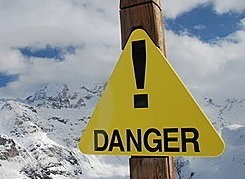Learn the hazards, a mountain discussion…

Mountaineering is dangerous. Injury or death is common on many extreme altitude mountaineering destinations and technical low-elevation alpine climbs. Mountaineering and alpine season around the corner in North America, so stay keen, but stay safe.
Dangers in mountaineering are sometimes divided into two categories: objective hazards that exist without regard to the climber’s presence, like rockfall, avalanches and inclement weather, and subjective hazards that relate only to factors introduced by the climber.
Gear failure and falls due to inattention, fatigue or inadequate technique are some subjective hazards.
A route swept by avalanches and storms is said to have a high level of objective danger. A technically more difficult route that is relatively safe from some of these dangers may be regarded as objectively safer.
Mountaineers must be aware of the dangers: falling rocks, falling ice, snow-avalanches, the climber falling, falls from ice slopes, falls down snow slopes, falls into crevasses and the dangers from altitude and weather. To select and follow a route using one’s skills and experience to mitigate these dangers is to exercise the climber’s craft.
Visit Parks Canada here for more on what to do during an accident.
For more on mountain hazards, visit wilderness survival here.
Grant Statham talks about the anatomy of chance:
A serac colapse / ice avalanche on the North Face of the Aiguille du Midi above Chamonix prompts a short discussion of this serious objective hazard in the mountains:


